This is probably my favorite spicy Chinese dish out there, and I’m on the hunt to track down places that offer it. Suggestions welcome! (And what better post for a good Midwestern Jewish boy to put up on Christmas Day?)
For those not familiar with the dish, it comes under a variety of names, and there’s certainly variation in the recipes. In fact, there are two classic recipes that both get referred to as Spicy Szechuan Peppercorn Chicken, in English anyway. There’s la-zi-ji – or “dried chili pepper chicken”, also known as chong-qing mala, or “numbing Chongqing” (referring to one of the cities of supposed origin, and the numbing quality of szechuan peppercorns) – both of which are also referred to as “dry fried spicy chicken”, indicating the lack of a sauce. Then there’s hua-jiao ji, or literally “szechuan peppercorn chicken”.
The biggest difference between the la-zi and hua-jiao versions of this seems to be whether it’s the dried chilies or the peppercorns that are the main spicing ingredient. The hua-jiao ji also includes bell pepper in the stir-fry, and is finished with a quick glaze of soy, rice wine, and sugar, setting it apart from the “dry fried” version. This puts it somewhere between la-zi and a traditional kung pao, a dish that most of us are generally more familiar with that adds in garlic, onions, carrots, and peanuts, generally, and has far fewer peppercorns and chilies.
At its most classic, it’s chicken that’s cut into bite sized pieces, bones and all, then stir-fried in oil with Szechuan peppercorns, dried red chilies, fresh ginger, soybean paste, and a splash of vinegar. Then it’s usually finished with green onions at the last minute. It seems to be optional whether the chicken is first marinated or not, when it is, it seems to be in a fairly simple mix of Chinese wine, soy, and cornstarch to either give it a crust or not. Garlic seems to be a split decision. Some recipes use it, most don’t, particularly those that seem to be more traditional ones. Sesame is, at most, an addition at the end, for presentation.
So far I’ve found seven versions of this dish in BA. All but one were the la-zi version. In order of trying them.
Shan Dong, Vera 468, Villa Crespo – the simply named Pollo picante (spicy chicken). Nuggets of chicken, lightly coated in cornstarch and fried, then stir-fried with a whopping amount of Szechuan peppercorns, dried chilies, sesame, and green onion. A touch saltier than I’d prefer. Even so, I want to move in with this dish – then again, it was the first place I found the dish in BA, so maybe I was just overwhelmed with happiness. 200 pesos.
Aroma China, Paraguay 2741, Recoleta – Here called Pollo frito picante, or spicy fried chicken. The chicken isn’t breaded and fried, it’s simply dusted in cornstarch and then fried, so over all less “bready”. And the spices are toned down a little bit here – it still has a nice hit of chili, szechuan peppercorn, and green onion, but not as intense, and far less salt. Recoleta. Figures. 160 pesos. [Closed 2019]
Jing Yue, Reconquista 873, Retiro – Instead of the more common crispy fried chicken, this one goes for a more gooey, cornstarch and sesame crust that’s golden brown, but soft – a step or so away from “dry fried”, but not glazed. It’s loaded with chilies, and garlic, and plenty spicy for my tastes, though I thought it could have used more of the Szechuan peppercorns and a bit more green onion. I’d happily eat it again, though there are better versions of the dish in town. Here simply listed on the menu as Pollo Frito (picante), or Fried Chicken (spicy), it comes in at 220 pesos. [Closed 2020]
Xin Le Yuan Mei Shi, Av. Juramento 1700, Locale 12, Belgrano – This is the only place that serves up what seems to be more the hua-jiao dish, just called “spicy fried chicken”. It’s got the bell peppers, it’s got a fair amount of garlic, it’s got the glaze. On the other hand, the chilies still were more present than the Szechuan peppercorns, which were barely noticeable, and it ought to be the other way around. I’ve still ordered it twice and happily eaten every bite. Approximately 200 pesos, but I forgot to make note of the exact amount. [Closed during the pandemic, and has been under renovation ever since… we shall see.]
Panda China, now Fortuna, Mendoza 1649, Barrio Chino – The pollo “panda china” picante. They don’t stint on the spice in this version, so you better like some fiery heat from the dried chilies, and some complete mouth numbness from the peppercorns. For me, that’s a plus, for others, it might be a bit overboard. Big plus on this version, the chicken is all boneless, whereas at most spots, and classically, it’s all chopped up bits with little bones sticking out of it. 285 pesos, which at first seems high, but really, this plate was enough for two people, though I’ve finished off a plate of it by myself, it’s that good. [Turned into a takeout spot for fried skewers and the like after the pandemic]
Xiao Long Bao, Anchorena 429, Once – Here called Salteado de pollo troceado picante (stirfry of spicy pieces of chicken). A very thin, crispy shell on the chicken, also all boneless, though a few bits of cartilage here and there – it’s in probably something like a cornstarch batter, perfectly seasoned and cooked, and wow, between the chilies, green onions, soy beans, and ginger, this one packed a punch – it’s also the only place I’ve seen the soy beans in the mix, which is part of the traditional recipe. The crispy noodles underneath are a nice touch. Smallest portion of the four places, and the most expensive, but we weren’t complaining. 360 pesos. [Closed, August 2018]
Beijing, El Salvador 5702, Palermo – This is one you have to order off the “real” menu – it took a couple of visits to Beijing to find out they have separate non-Chinese and Chinese folk menus. The latter is almost double the length and includes more dishes like this, plus dim sum, and is thankfully, translated into Spanish as well. [Closed during the pandemic]
Unfortunately, this is probably the only dish I’ve not been overly fond of at Beijing over several visits. The flavors are fine, and plenty of spice, but it’s fried to the point of being crunchy chicharrón-like bits of chicken – there was virtually no moisture left in the dish. Plus, the chicken was sort of raggedly chopped, leaving splintered bits of bone sticking out, and you have to be careful eating it.
I found myself wondering if it was this way simply because we were there on a day when the place was literally packed to the gills with people waiting – Christmas Eve lunch – and they just weren’t taking the care with things they normally do. We also found the other dishes we had that day, which we’ve had before, to be a bit off of normal. It’s still good, it just felt like they’d taken the dry frying too far – probably in a deep-fryer. 290 pesos.
It didn’t stop us from finishing it off, but it was more like eating spicy popcorn than anything else. I’d like to go back and try it again on a day when they aren’t so packed.
[A revisit on a “normal” evening. Tried the dish again and it came out basically perfect. Not over-fried, not greasy, the chicken was carefully cut into pieces that weren’t jagged. And far spicier than the first time around.]
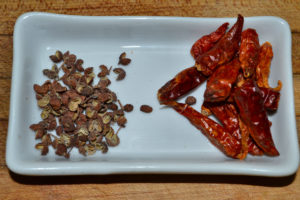
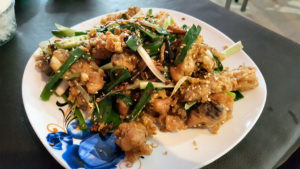
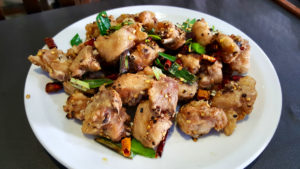
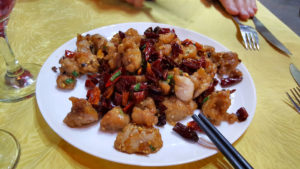
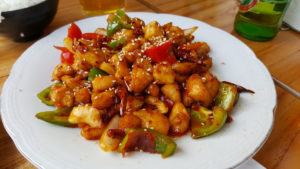
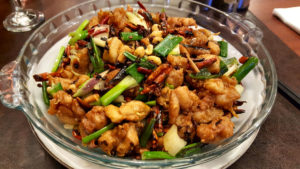
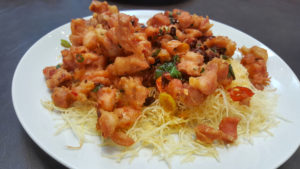
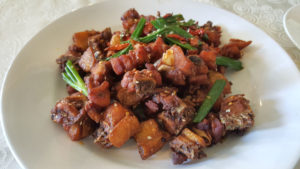
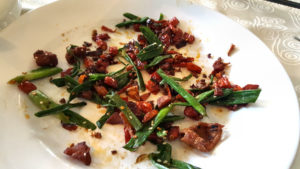
[…] to the chicken section, lo and behold, they had a version of Spicy Szechuan Peppercorn Chicken – in this case, the hua jiao ji style, with bell peppers, garlic, and ginger. It’s a […]
Royal China, Av. Alicia Moreau de Justo 1808, Puerto Madero. Turning to the chicken section, lo and behold, they had the hua jiao ji style, with bell peppers, garlic, and ginger. It’s a decent sized portion. It could have been spicier, especially as I’d asked for it to be. Heavy on the garlic and ginger – in fact, whole garlic cloves and similar sized planks of ginger, and just a small amount of chili and a hint of szechuan peppercorns. It was good, but no more than that. It took three requests to get a bowl of white rice to accompany it. 328 pesos, plus 60 for rice…. Expensive, not worth it, and a restaurant with really inhospitable service.
[…] into English as razor, but on searching for the dish online, Google instantly goes to laziji, or, Szechuan peppercorn chicken. No peppercorns. Not spicy. Not a dish I’d care to eat again. 300 […]
[…] I’d asked her if they had Spicy Szechuan Peppercorn Chicken, my personal favorite, and she did, though insisted that it was so spicy there was no way that a […]
[…] regular readers know my favorite Szechuan dish, Szechuan peppercorn chicken, la zi ji. Very good version of this dish – the majority of the pieces of chicken boneless, […]
[…] love a sticky, spicy and sweet, gotta wear your plastic glove Korean fried chicken? Or a Chinese Szechuan Peppercorn version (I know, it’s chopped up bits, but it’s fried chicken)? And, of course, being […]